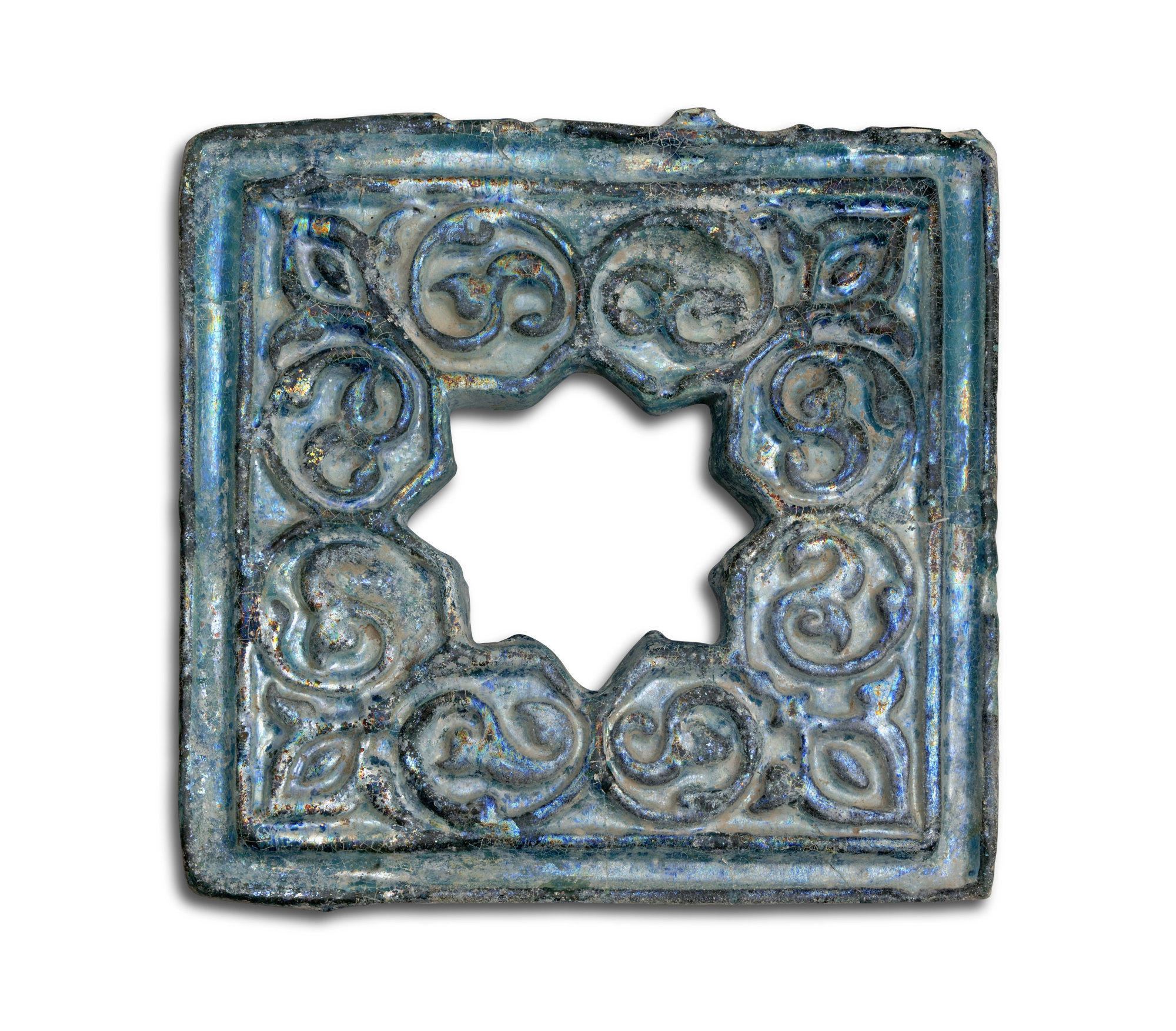Click on the image to zoom
Tile
- Accession Number:AKM702
- Place:Syria
- Dimensions:36.5 x 36.5 cm
- Date:1150–1250
- Materials and Technique:Fritware
This moulded tile is decorated with split-palmette scrolls radiating from a central aperture in the form of an eight-pointed star, while a tri-lobed palmette motif marks each of its four corners; the entire decoration is framed within a border formed by a raised line. The tile has been covered with a transparent turquoise glaze and resembles other moulded wares made in the same technique and attributed to Syria in the twelfth and thirteenth centuries. Connections may also be made to ceramics produced in the neighbouring Iranian world, as suggested by a moulded tile in the David Collection, Copenhagen, covered with turquoise glaze and including sixteen small, evenly-spaced, eight-pointed star-shaped apertures (von Folsach 2001, p. 167 [no. 208, inv. no. 5/1980). So-called Raqqa ware - which, over time, has come to refer to a wide range of pottery, including certain kinds of lustreware, underglaze painted wares, monochrome-glazed wares, and Laqabi and “Tell Minis” wares - has been the subject of several studies, especially in recent years. The city, located on the left bank of the Euphrates River in Syria, is one of the first archaeological sites where Islamic ceramics were excavated. It was once assumed that wares resembling the ones found at Raqqa were produced in that city and then travelled to other regions, such as Anatolia, Iran, and Egypt (for a summary of previous scholarship on Raqqa ware, see Jenkins-Madina 2006, pp. 7-8). More recently, Oliver Watson suggested that a similar range of ceramic wares were produced at other sites throughout Syria and that there is strong evidence for Egypt being a centre of production for wares of equal or higher quality, with the exception of lustreware (Watson 1999 and Watson 2004, p. 289). The latest study of Raqqa ceramics was conducted by Marilyn Jenkins-Madina, who examined a group of ceramics of this type found in Konya alongside the Raqqa wares in the collection of The Metropolitan Museum of Art. Jenkins-Madina concludes that these works were produced in the first three decades of the thirteenth century while the Ayyubid dynasty was in power (1169-1260 CE), a period which corresponds specifically to the residence of the Ayyubid prince al-Malik al-Ashraf Musa in Raqqa and his patronage of an extensive building program for the city (Jenkins-Madina 2006, pp. 186-87). Soon after this time, Raqqa was occupied by the Rum Saljuqs and the Khwarazmshahs and it was eventually destroyed by the Ilkhanid Mongols in 1265 CE.
References
Kjeld von Folsach, Art from the World of Islam in The David Collection. Copenhagen: Davids Samling, 2001. ISBN: 9788788464214
Marilyn Jenkins-Madina, Raqqa Revisited: Ceramics of Ayyubid Syria. New York: The Metropolitan Museum of Art, New Haven and London: Yale University Press, 2006. ISBN: 9780300111439
Oliver Watson, ‘Museums, Collecting, Art-History, and Archaeology’, Damaszener Mitteilungen 11 (1999): 42–32. ISSN: 0176-2354
Oliver Watson, Ceramics from Islamic Lands. London, 2004. ISBN: 9780500976340
Note: This online resource is reviewed and updated on an ongoing basis. We are committed to improving this information and will revise and update knowledge about this object as it becomes available.


